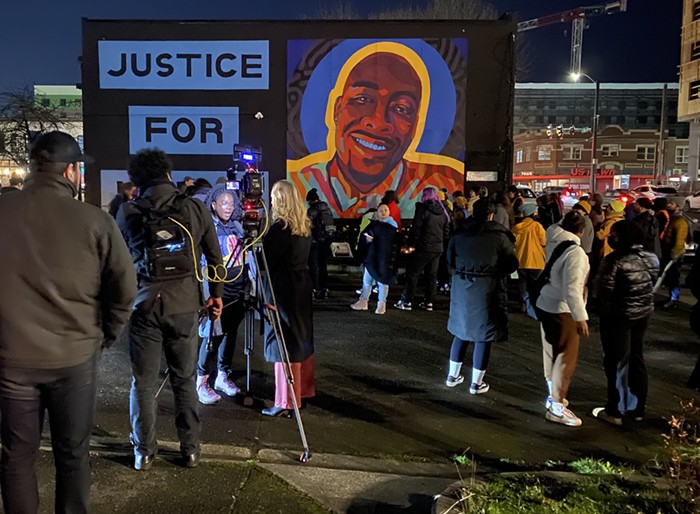
Seattle City Councilmember Alex Pedersen came to the Low Income Housing Institue (LIHI) earlier this year with a plan. What if the city turned the vacant Sound Transit lot right across from the University District Trader Joe's into a temporary tiny house village?
Pedersen is a self-described tiny house skeptic, and he's been a consistent "no" vote on tiny house legislation in the past, including a February council measure that expanded tiny house zoning capacity in the city, which paved the way for Pedersen's new proposal. Is this... character development?
Sort of. Pedersen said several factors spurred him to propose funding in the budget for a tiny home makeover at the U District Sound Transit site. Those factors included "unauthorized encampments seeming to increase in [District Four]," new data showing that the tiny house model effectively connects people to permanent housing, and an increased sense of urgency due to the pandemic.
Pedersen's proposal is part of Seattle's plan to create 425 more non-congregate, COVID-19-safe shelter spaces for people who currently sleep on the streets. Right now there are around 8,166 people living outside in Seattle, which makes the tiny homes proposal a solution for around 5% of the need. The other strategies include leasing hotel rooms, adding enhanced shelter space, and building more tiny homes. While new tiny home programs have been funded, the city has yet to develop a plan to decide who will receive this limited number of new shelters.
The 2021 budget included $4.2 million for three new tiny house villages in the city. Seattle currently has nine villages. According to 2019 data from LIHI, in the four years since Seattle introduced the model, 2,520 homeless people have lived in a tiny house and 20% have moved out of the villages and into permanent housing, such as apartments or houses. However, of the 325 people who left tiny homes in 2019 alone, 44% moved into permanent housing. This is the data that won Pedersen over, catalyzing his U District plan.
If Sound Transit determines it doesn't need the site for the opening of the U-District Station next year and approves LIHI's request to use the site, a new temporary village will host around 45 to 50 tiny homes on the vacant Sound Transit lot for $1,400,000 of one-time construction fees and ongoing operating costs. The price tag is a bit lower than typical tiny home start-up costs because Sound Transit already leveled the ground, threw down some gravel, and set-up energy hook-ups. Sharon Lee, executive director of LIHI, said that work saves about $100,000, money which will be spent hooking up things like plumbing and kitchens. Ideally, the village will open in early 2021, Lee said.

In about two years, or whenever the agency gets around to it, Sound Transit will take back the lot to build affordable housing units—a sexy little change to state law mandates surplus land from transportation projects must be built into housing.
The village will be the U District's first non-congregate shelter solution, but, despite claims from LIHI and the neighborhood's business groups, it's unclear whether the village will temporarily house the people sleeping on the neighborhood's streets.
Maureen Ewing, the co-chair at the U Heights community center, called the tiny house village a "win-win" for the U District, a neighborhood that has historically had a large unhoused population, especially unhoused youth. Ewing said she noticed the number of people on the streets of the U District tick up since the pandemic began, and she hopes the village will address "some of the need" in the neighborhood.
According to Mark Crawford, the executive director of the University District Partnership, the UDP board and the U District Business Improvement Ratepayer Advisory Board "were gratified to hear that LIHI would prioritize unsheltered individuals from the University District once the village was established and accepting residents."
However, Will Lemke, spokesperson for the Human Services Department, said that LIHI couldn't promise that prioritization since "these programs are not designed to be exclusively available to a single neighborhood."
Lemke said the city is still trying to figure out how referrals will work with the outreach response team the council created after it killed the Navigation Team this summer. The new program is called the Homelessness Outreach Provider Ecosystem, aka HOPE. This five-person team of housing and social service providers are supposed to coordinate outreach efforts and shelter connections, not the shelter providers themselves.
HSD already gave LIHI some heat for circumventing the new HOPE process by connecting 15 people living in John C. Little Park to tiny homes without any input from HSD, reports Erica Barnett with PubliCola. HSD said HOPE is still standing up its referral process, and that LIHI needed to consult with HSD in order to refer people to their tiny homes.
Barnett raised a concern about whether the new system—which is bound to be bogged down by city processes—could cause outreach providers to circumvent the process or create loopholes politicians could potentially exploit to benefit their own districts. For now, it seems that HSD is clamping down on any preferential referrals. "These programs are not designed to be exclusively available to a single neighborhood," Lemke said, "but designed to meet people’s unique needs to end their homelessness."
As far as referrals for this U District tiny house village, Lee said, "everything is still in flux." That uncertainty may not have been communicated to the Ravenna-Cowen Community Alliance, a local neighborhood group that was formed after tent encampments cropped up in Ravenna and in Cowen Park to "speak up for the parks."
The group of 200 to 300 community members is volunteering to build the tiny homes at the new village, excited about the prospect that people living in their local park encampments will move into the new homes. One of their members, Theresa Barker, who wrote this op-ed, said she organized countless email campaigns to council members (always personalized, never copy-pasted form emails, she said pointedly, clearly making a swipe at Councilmember Kshama Sawant's Socialist Alternative). Barker believes the village is a success born out of her "citizen activism."
With the village, Barker said she's happy to finally make a personal impact on the lives of the people living outside. We'll see how those email campaigns change once HSD finalizes the referral process. Regardless of how things shake out, Lee with LIHI believes "homeless people in the neighborhood will "still be able to access the [tiny house] site."



















